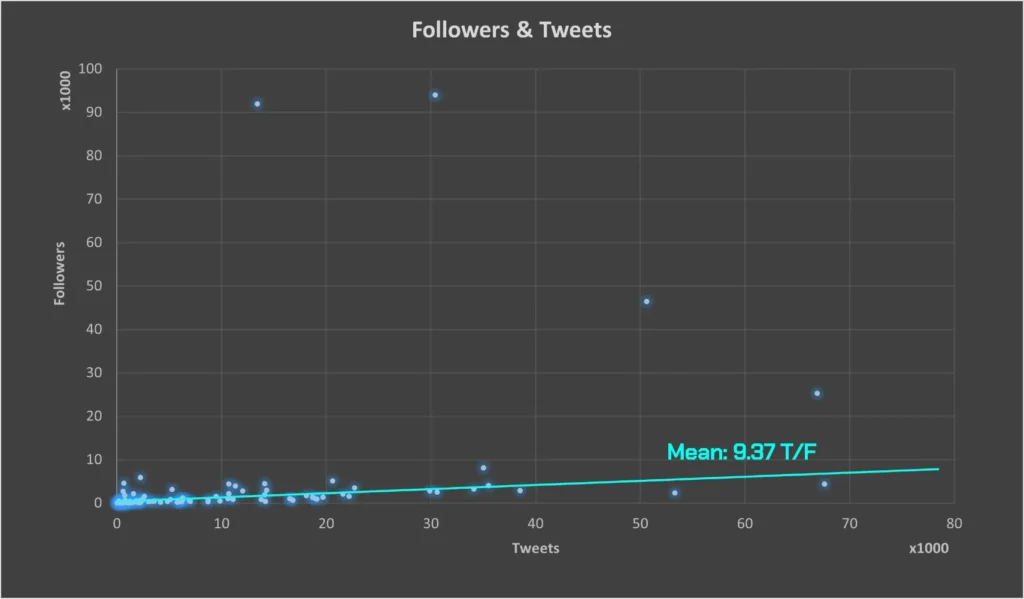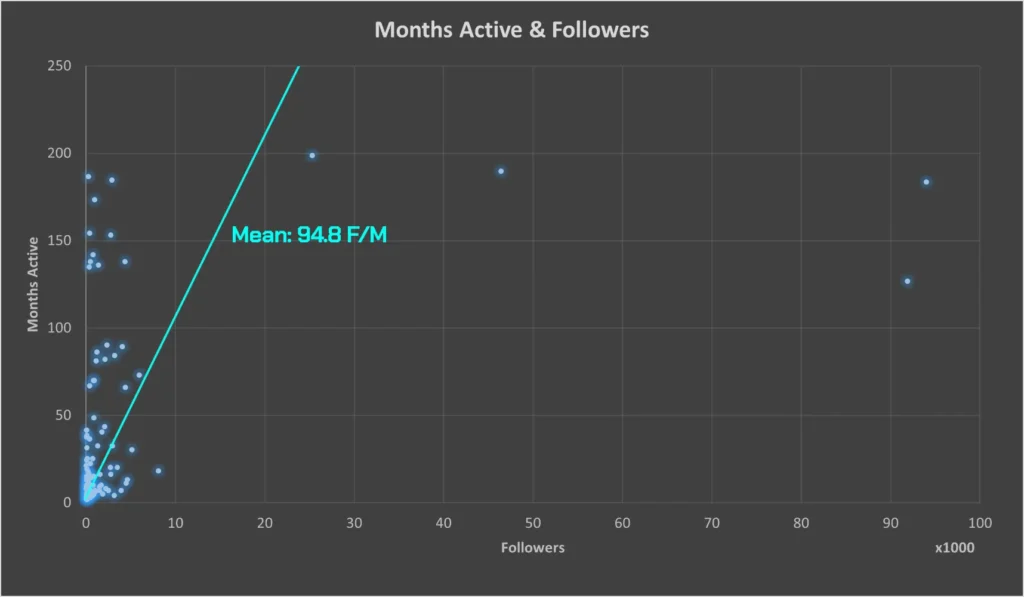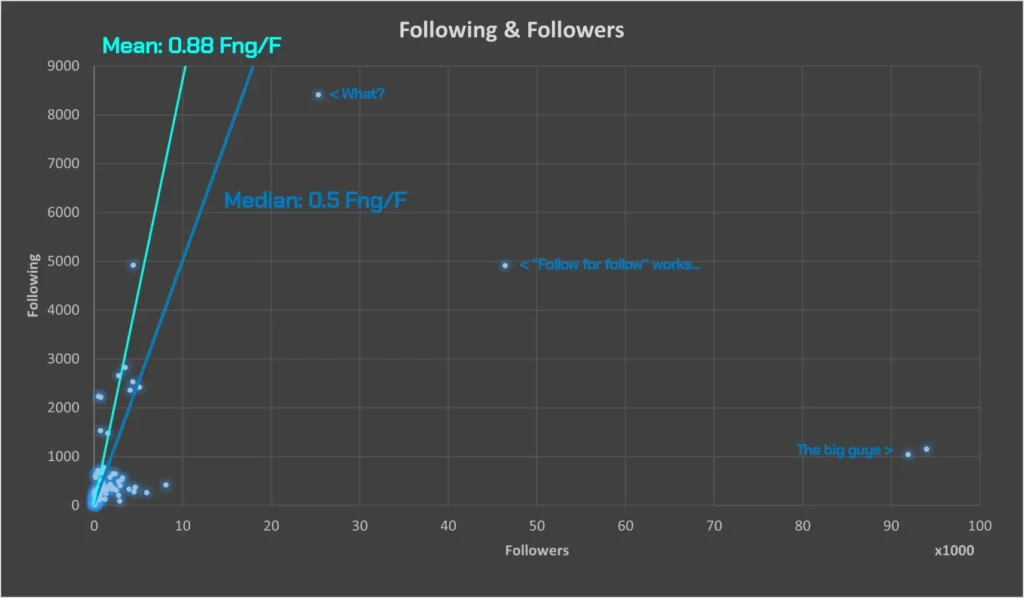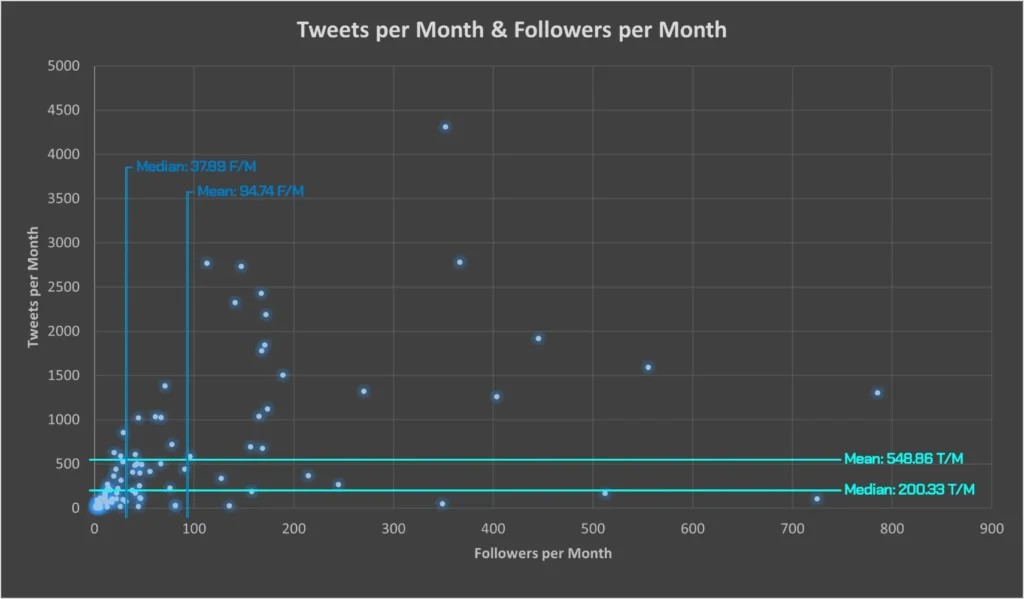
How Many Tweets Does it REALLY Take to Gain a Follower?
Let’s face it, we’ve all seen those “overnight success” tweets boasting about follower explosions. But have you ever wondered what the real story is behind the numbers?
I recently stumbled upon a tweet that piqued my curiosity and put me on the path of relentless research.
I've written over 10k tweets.
— Tim Schreiber (@TimSRD_) May 8, 2024
In 5 months.
Think it was luck?
Think again.
It claimed the author wrote over 10,000 tweets in 5 months – with a follower count just shy of 2,200 at the time of data analysis.
That translates to roughly 4.9 tweets per follower. Yikes! My gut instinct screamed “Slow growth!”, doesn’t yours?
But hold on a second. Since Analytical Thinking is my middle name, I decided to dig deeper.
Here’s the thing: there’s no magic tweet-to-follower ratio. It’s more like a benchmark number you can reference yourself to. Which brings us to the following:
Shedding Light on Some “Average” Twitter Stats
Just to clarify; I sifted through a mountain of data (all manually, to ensure real people, not bots, were involved). This took a long time.
Here’s the short rundown in video format:
So here’s the full rundown of all “means and medians” you can calculate from a large data set of Twitter profiles, so you know where you stand with your own.
How Many Times Do You Have to Tweet to Get One Follower?
On average, to snag a single follower, you’ll need to tweet roughly 9.37 times. The median, which is basically the middle number, sits at a slightly lower 7.58 tweets per follower.
So, in this case, 4.87 tweets per follower for our “reference tweeter” actually looks pretty good!

A clear correlation is visible when plotting the number of followers of any given X account against the number of Tweets said account has published.
So, apparently, the more you tweet, the more followers you have. Or maybe it’s the more followers you have, the more you tweet…
But does this mean that you throw out bogus tweets and easily grow on X? Maybe yes, but not likely.
Solid insight, right?
But wait, there’s more! There are many more factors that influence follower growth on X.
Additional Twitter Metrics to Know
My analysis revealed some fascinating patterns in the data. Here’s a detailed breakdown of some interesting metrics you might want to know.
Account Age Matters (A Lot)
Turns out, the longer your account’s been around, the more followers you tend to have. That makes sense, right?
But here’s the kicker: account age is almost as important as the number of tweets you crank out.
Check this out:

As before (with tweets per follower), correlation is measurable (and visible) on the scatter plot.
It’s not a strikingly obvious trend, but it’s there; The longer you’re on X, the more followers you have. But does this mean that you can just create an X account and let it sit?
Well, yes. It quite simply could! But…
We have to take into account that older X profiles typically have posted more often than fresh accounts. So, we should maybe put this data in relation to the number of Tweets, right?
I’ll get to that shortly.
Follow-for-Follow Works
Have you ever heard of “follow-for-follow”?
It might sound a bit too easy, but the data suggests the more people you follow, the more likely they are to follow you back. Shocking, I know!
The average following/follower ratio is 0.88, meaning most accounts have one follower for every 0.88 people they follow.
And here’s the interesting part:

A really high following/follower ratio hints at a profile trying to hack “follow for follow”.

In fact, there are many “bot accounts” that have Fng/F ratios way in the double digits. Yes, those are so obviously bot accounts…
The example screenshot shows such a bot account with an astronomical following/follower ratio of approximately 63.98.
That’s just sad.
The More You Post, the Faster You Grow
No surprise here, the more you tweet per month, the more followers you tend to gain. But the real eye-opener lies in the rates.
The average user tweets a whopping 548 times a month! Thankfully, the median is a somewhat saner 200.33 tweets.
Do you realize that this means the average X account (in my analysis) posts roughly 18 times PER DAY?!
Now, those folks posting 548 times are also racking up an average of 94 new followers monthly. Impressive, but definitely not sustainable for most of us – unless you earn serious money from it.
Here’s even more insane stuff:

As I promised before, here’s the scatter plot showing the followers per month in relation to the number of Tweets per month. It clearly shows a correlation between the growth rate of an account and its Tweet rate.
This means that the more often you Tweet and the longer you’ve had your account, the more followers you have – both tweet rate and account age being of similar importance.
It also means that the more you Tweet per month, the more followers you gain per month.
So no, just letting your account sit and posting nothing at all isn’t a real option if you want to grow quickly.
Important Twitter (X) Benchmarks
Let’s translate all this data into actionable insights, so you can calculate where your X profile stands. Here are a few benchmarks to help you gauge your Twitter performance:
Tweets-per-Follower Ratio
T/F Ratio = Nr. of Tweets / Nr. of followers
Calculation
Aim for anything below 9.37 tweets per follower, with under 7.58 being a stellar achievement.
This indicates you’re delivering valuable content that resonates with your audience.
Following-Follower Ratio
Fng/F Ratio = Nr. of Accounts FollowING / Nr. of FollowERS
Calculation
A following-follower ratio of 0.88 or lower is good, with anything under 0.5 being fantastic.
This means people follow you because they’re genuinely interested, not out of social obligation, a.k.a. pressure of reciprocity.
The “TMFF”
This one’s a bit more complex, but hear me out.
I created a metric called the Tweets per Month Adjusted by Following/Follower Ratio (TMFF) to assess an account’s overall Twitter health.
Don’t worry, the fancy name doesn’t mean a complicated calculation.
TMFF = ( Nr. of Tweets / Nr. of Months Active ) / ( Nr. of Accounts FollowING / Nr. of FollowERS )
Calculation
Here’s the gist: a higher TMFF is generally better and means your account is healthier.

The average sits at a hefty 2823.33 because there are quite a few accounts with stellar TMFFs in the tens of thousands. So, the median (being at 607) is a much better reference number.
Fun fact: The account with the highest TMFF in my analysis has one of 37279.90!
A TMFF under 200 isn’t good and might indicate a lack of activity, questionable practices, or a content strategy that’s missing the value mark.
Conversely, anything over 607 suggests you’re doing something (or quite a lot) right!
A Caveat
Now, just because I’ve analyzed some data, doesn’t mean my analysis is 100% correct. In fact, it likely isn’t (it’s more like 90%).
I’ll be updating this post from time to time with more and fresher data to reflect the changing landscape of X and social media in general.
We’ll see what happens to the results over the course of the next few months, years, or even decades.
I hope you got some insight into how well you might be doing on X – at least in comparison to other profiles out there.
Pay attention to your T/F ratio (strive for under 8 or so), your Fng/F ratio (keep it under 0.5), and your TMFF (over 600 or so).
I’m planning on creating a calculator of sorts where you can just enter your number of published Tweets, followers, and followings, plus your account age. It’ll then calculate all these metrics for you.
For now, though, you’ll have to make do with calculating it all by yourself, sorry.
Thanks for reading! Here are a few other posts you might like:






